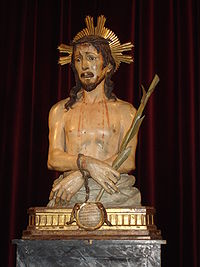Ramon Amadeu
Ramon Amadeu i Grau (* 1745 in Barcelona ; † 1821 there ) was a Catalan sculptor .
Life
Amadeu was a student of Josep Trulls in Barcelona and later of Lluís Bonifaç in Valls , Province of Tarragona . The latter in particular brought him far forward in his artistic development. In 1770 he joined the Barcelona sculptors' guild. Two years later he applied for admission to the Real Academia de Bellas Artes de San Fernando in Madrid . However, he only succeeded in doing this in 1778 with the presentation of a deep relief . As a result, he freed himself from the restrictions he experienced from the guild system in Barcelona. At the same time he was able to set accents in the academic art world with his work. Before and during the war of independence against Napoleon (1807-1812) he lived in Olot .
plant
Amadeu's work can be thematically divided into two main groups:
- Nativity figurines
- Figures for the religious cult
Most of his wooden figures have been lost. Some are only known as a photo. Its style contains elements from the Baroque period with some neoclassical features. In terms of art history, his work can be divided into three categories:
- Purely baroque works
- Baroque works with neoclassical influences
- Purely academic works
The nativity scene (Catalan: el pessebrisme ) existed in Catalonia long before Amadeu. When King Charles III (* 1716; † 1788) arrived in Catalonia from Naples, this tradition got a huge boost, because in Naples it was far more deeply rooted. Amadeu is considered to be the leading exponent of this Catalan nativity scene. The crib figures made of polychrome clay were good opportunities for experimentation for Amadeu, as they were technically easy and quick to produce. This is where Amadeu acquired his great design competence. His work can be characterized particularly well by the following three qualities: 1.) A great love for the natural, 2.) An extremely fine detail work with anecdotal and picturesque features, 3.) A love for small figures. The Museum Comarcal de la Garrotxa in Olot presents examples of such nativity figurines made of polychrome clay, such as the bagpiper or shepherd with sheep .
Famous works
- The mystery of Santa Espina (el Misteri de la Santa Espina, Barcelona Sailing Guild )
- Saint Ignatius (el Sant Ignasi, Barcelona Cathedral)
- Dead Christ (un Crist diffunt, Figueras )
- Saint Anne with the Virgin (un Santa Anna amb la Verge, Kunstmesuem Barcelona)
- Ecce Homo (Ecce Homo, Maria del Tura Church, Olot )
- Many nativity figurines in the Historical City Museum of Barcelona, in other museums in the city, in the Garrotxa Museum, Olot and in several private collections.
literature
- Arnau i Prades, M. Assumpció; Sala i Plana, Joan: L'art olotí en el XIX i XX . Ramon Amadeu a Olot. 1st ed.Diputació de Girona, Girona 2013, ISBN 978-84-15808-03-9 , pp. 16 f . (Catalan).
Web links
- Google Arts & Culture: Ramon Amadeu. Accessed April 12, 2018 .
- Enciclopèdia.cat: Ramon Amadeu i Grau. Retrieved March 31, 2018 (Catalan).
| personal data | |
|---|---|
| SURNAME | Amadeu, Ramon |
| ALTERNATIVE NAMES | Amadeu i Grau, Ramon |
| BRIEF DESCRIPTION | Catalan sculptor |
| DATE OF BIRTH | 1745 |
| PLACE OF BIRTH | Barcelona |
| DATE OF DEATH | 1821 |
| Place of death | Barcelona |


